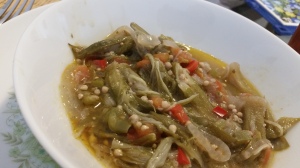Summer evenings in the neighborhood can be wonderful. Occasionally on a Friday some of us neighbors bring out folding chairs and sit together in one front yard for a bit of happy hour while the kids go mental on someone else’s lawn. It’s pretty much BYO, but we do mix up a pitcher of experimental cocktails sometimes. Or at least I do.
 These Passionfruit Mojitos (which I call “Monrojitos” after our street) were very pretty and tasty. I brought over a cooler with the rum mix, lime wedges, mint and ice, and we muddled each drink individually, which made it festive, somehow. Individuals can adjust lime if they want it a bit more tart.
These Passionfruit Mojitos (which I call “Monrojitos” after our street) were very pretty and tasty. I brought over a cooler with the rum mix, lime wedges, mint and ice, and we muddled each drink individually, which made it festive, somehow. Individuals can adjust lime if they want it a bit more tart.
(This recipe gives general proportions. For a pitcher, measure by the Cup; for individual servings use ounces)
3 parts white rum
2 parts passionfruit juice or nectar (nectar will be sweeter)
1 part sugar syrup (put equal parts water and white sugar in a saucepan, bring to a boil, lower heat and simmer until slightly thickened; 1 Cup of sugar and one of water will yield about 1.5 Cups of syrup)
OR
1 part agave syrup
Mint leaves (you’ll need at least three per glass)
Limes, quartered (at least two quarters per glass)
ice
Club soda or seltzer
Mix rum, juice and syrup in a pitcher or bottle you can close tightly and keep chilled. When you are ready to serve, place mint and lime in each glass and muddle (squeeze and press so tha the juices come out). Add ice, pour desired amount of rum mixture and top with a bit of club soda.











































